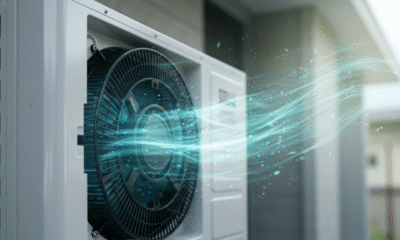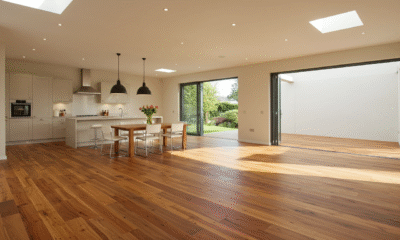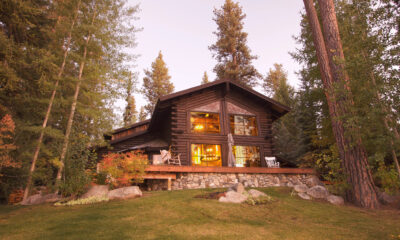There are a lot of reasons that people enjoy living in older homes. Unfortunately, there is a downside – they are not the eco-friendliest properties around. We talked about the need to lower your carbon footprint as a homeowner, which can be more challenging in an older home.
Fortunately, there are steps you can take to make them eco-friendlier. One study found carbon emissions of old homes can be cut by 84% with the right changes.
There are a number of reasons that older homes are not as good for the environment as we would like:
- They tend to be less energy efficient, because they have inferior insulation and often have a lot of cracks and other sources of drafts. This requires more energy to heat and cool them, which obviously isn’t as good for the environment.
- They are made from less environmentally friendly materials. This includes toxic paint, lead, asbestos and other materials that are not as good for the planet.
- Since they tend to have more problems, they require a lot more maintenance. Replacing parts isn’t as good for the planet, because it requires you to use raw materials that have to be extracted from the planet. You may also have to pay a home improvement expert to travel to your house, which is going to leave a larger carbon footprint since they have to drive over.
It is clear that older properties aren’t highly eco-friendly. However, replacing them would arguably be even worse for the environment.
As an eco-friendly home owner, you are going to need to make your older property as sustainable as you can. This is going to require you to focus on making the right improvements. For example, you can make changes to make them more energy efficient.
What You Need to Consider When Renovating Your Old Property to Make it Eco-Friendlier
What can you do with an old house that was built at the beginning of the last century? It has lost its former beauty and strength, surrendering to insects and moisture. It has also become far less environmentally friendly over time. You have to leave a large carbon footprint to keep yourself warm in the summer and eroding parts of the home may cause toxins to leech into the earth.
Should you demolish such a building or try to remodel it? Both options will require financial and time investments. They also both require you to use natural resources and energy intensive tools, which is going to cause problems for the environment.
Remodeling is often cheaper and takes less time. Remodeling is usually a better option for the planet as well, unless the house is very badly dilapidated. To make a final decision, you need to know what stages the reconstruction of the house includes, the problems the process will cause for the planet, what will need to be done, and how much it will cost. At least, you must approximately know all the stages of reconstruction.
Is Reconstruction Needed?
Reconstruction is carried out to improve living conditions. From cosmetic and preventive repairs, which are carried out every 3-5 years, reconstruction is distinguished by the scale of actions. Depending on the condition of the building, it may be necessary to replace floors and roofs, the foundation, or even add another floor. This cannot be done independently, so you will need the help of professionals from Hawaii Trusted Realty. Before deciding whether to repair, remodel or even demolish a building, it is necessary to assess its condition. Remodeling is recommended in the following cases:
- deformation of the foundation, as a result of which cracks may occur. Problems with the foundation can also be suspected when the house is skewed when windows and doors begin to open and close with difficulty;
- the beams are so rotten that there are problems with the leaking roof;
- it is worth checking not only the outer layer of wood but also the inner one – it can be rotten. The top layer of wood can be checked with a knife, the bottom layer with a hammer and drill;
- walls are highly permeable to moisture;
- the toxins in the materials and the impact they will have on wildlife if released into the environment
With the reconstruction of ceilings, foundations, and walls, many request the expansion of living space. This is also considered one of the stages of reconstruction. You can add another floor, an attic, or another room.
You will want to find out whether the home improvement professionals are trained to handle the process in an eco-friendly manner.
Stages of Reconstruction
When reconstructing a house, it is crucial to identify all the weaknesses of the building and correctly perform construction works. Remodeling of a private house takes place in several stages:
- technical expertise to assess the condition of the house and determine the necessary reconstruction tasks;
- development of a project, budgeting;
- strengthening the foundation, or its complete replacement;
- wall repair;
- redevelopment of the premises;
- roof renovation;
- replacement of engineering communications;
- facade work.
All of these processes can be done in the most environmentally friendly manner. However, you will need to monitor the process and make sure the professionals know what they are doing.
There Are Eco-Friendly Ways to Renovate Old Properties
There are ways to be an environmentally conscious citizen while living in an old home. However, you are going to have to know how the home can be remodeled.
During the reconstruction, it will be possible not only to make the house more reliable and stable but also to increase the comfort of the building significantly. You can increase the living area, build a terrace or a garage, install a fireplace, insulate the building and equip the facade. The company that does the renovation will prepare a project, create 3D models, and calculate the cost of work and materials. Remember that it is easier to entrust all the work to people who will do everything efficiently and quickly.
Of course, there are other steps that you can take to make your old home eco-friendly. You may want to try investing in renewable energy as well. This can make a big difference.


 Environment10 months ago
Environment10 months agoAre Polymer Banknotes: an Eco-Friendly Trend or a Groundswell?

 Environment11 months ago
Environment11 months agoEco-Friendly Home Improvements: Top 7 Upgrades for 2025

 Features9 months ago
Features9 months agoEco-Friendly Cryptocurrencies: Sustainable Investment Choices

 Features10 months ago
Features10 months agoEco-Friendly Crypto Traders Must Find the Right Exchange





























